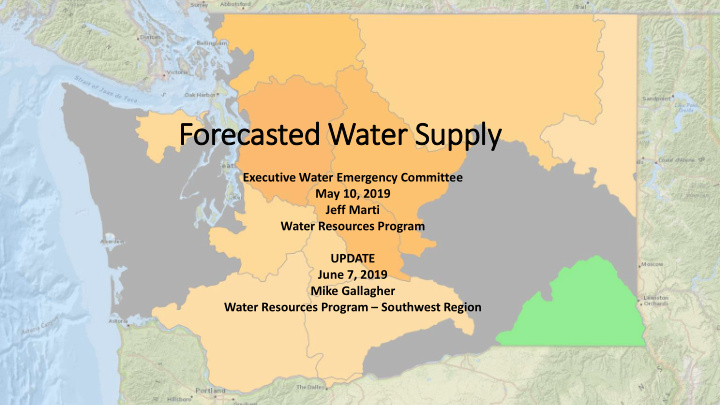



Forecasted d Water Suppl ply Executive Water Emergency Committee May 10, 2019 Jeff Marti Water Resources Program UPDATE June 7, 2019 Mike Gallagher Water Resources Program – Southwest Region
173-166-030 Definitions. (2) "Drought conditions" are water supply conditions where a geographical area or a significant part of a geographical area is receiving, or is projected to receive, less than seventy-five percent of normal water supply as the result of natural conditions and the deficiency causes, or is expected to cause, undue hardship to water users within that area. (5) "Geographical area" is an area within the state of Washington which can be described either by natural or political boundaries and which can be specifically identified in an order declaring a drought emergency. Examples of specific geographical areas include, but are not limited to: (a) The state of Washington. (b) Counties. (c) Water resource inventory areas (WRIAs) as defined in chapter 173-500 WAC. (d) Individual watersheds which constitute only a portion of a WRIA but whose boundaries can be topographically described. (e) Groundwater management areas and subareas as defined in chapter 173-100 WAC. (f) Designated sole source aquifers. (g) Combinations of the above areas. (6) "Normal water supply" is for the purpose of determining drought conditions, the median amount of water available to a geographical area, relative to the most recent thirty-year base period used to define climate normals. The determination of drought conditions will consider seasonal water supply forecasts, other relevant hydro-meteorological factors (e.g., precipitation, snowpack, soil moisture, streamflow, and aquifer levels) and also may consider extreme departures from normal conditions over subseasonal time frames. (emphasis added)
Washington State’s Drought Trigger Less than 75 Percent of Normal Water Supply Drought Hardship RCW 43.83B.400
Funding now available to public agencies for drought relief - June 4, 2019 OLYMPIA – Public agencies experiencing hardships related to drought conditions may now be eligible for funds to ease drought-related effects. Beginning today, the Washington Department of Ecology is accepting applications for grants. Public agencies, such as towns or irrigation districts, can apply for up to $350,000 which must be matched by the applicant. The grants could be used for projects such as emergency standby wells for rural communities, or help for hatcheries to maintain cool clean water for fish. The 2019 Legislature appropriated $2 million for drought response. “This funding is meant to help our communities be more resilient,” said Mary Verner, Ecology’s Water Resources Program manager. “Conditions are expected to worsen over the summer and we want to be able to act quickly if needed.” Last month, the state expanded the drought emergency that was declared in April and now includes a total of 27 watersheds. This designation allows Ecology to expedite emergency water right permitting, as well as making funds available to address hardships caused by drought conditions. “We’re coming out of a mediocre snowpack winter with lower-than-normal precipitation,” said Jeff Marti, Ecology’s drought coordinator. “Additionally, we’re seeing some of the driest conditions on record in the northwest part of the state, while locations in the southeast have experienced recent flood watches.” There are two factors considered for the state to issue an emergency drought declaration: Water supply conditions that are currently or projected to be at or below 75 percent of average, and a projection of undue hardships. For more information about the grants or to apply, please visit Ecology’s drought website.
2005 2001 2015 Count of emergency drought Permits during previous statewide drought years
Recommend
More recommend